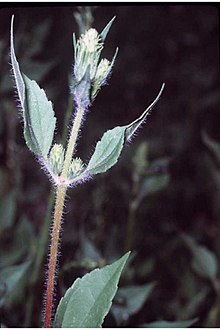Iva annua
| Iva annua | |
|---|---|

| |
| Scientific classification | |
| Kingdom: | Plantae |
| Clade: | Tracheophytes |
| Clade: | Angiosperms |
| Clade: | Eudicots |
| Clade: | Asterids |
| Order: | Asterales |
| Family: | Asteraceae |
| Genus: | Iva |
| Species: | I. annua
|
| Binomial name | |
| Iva annua L. 1753
| |
| Synonyms[2] | |
| |
Iva annua, the annual marsh elder[3] or sumpweed, is a North American herbaceous annual plant in the family Asteraceae that was historically cultivated by Native Americans for its edible seed.
Description
[edit]Iva annua is an annual herb up to 150 cm (5 feet) tall. The plant produces many small flower heads in a narrow, elongated, spike-like array, each head with 11–17 disc florets but no ray florets.[4] Marshelder has a unique odor when the leaves or pollen are touched, but this odor is not present in winnowed seed.
Cultivated varieties of Marshelder (var. macrocarpa) bred by Native Americans possessed seeds 6-9mm in length; whereas wild-type Marshelder has seeds 3 mm in length on average (not exceeding 4.5 mm). [5]
Distribution
[edit]It is native to northeastern Mexico (Tamaulipas) and to the central and southern United States, primarily the Great Plains and Mississippi Valley as far north as North Dakota. There are some populations in the eastern US, but these appear to represent introductions.[6]
Conservation
[edit]NatureServe evaluated Iva annua in 1998 as globally secure, G5.[1]
Uses
[edit]Iva annua was cultivated for its edible seed by Native Americans around 4,000 years ago[7] in the central and eastern United States as part of the Eastern Agricultural Complex. It was especially important to the indigenous peoples of the Kansas City Hopewell culture in present-day Missouri and Illinois. The edible parts contain 32 percent protein and 45 percent oil.
However, like its relative ragweed, sumpweed possesses many objectionable qualities which include being a severe potential allergen and possessing a unique odor. Probably for these reasons it was abandoned after more pleasant alternatives (such as maize) were available and, by the time Europeans arrived in the Americas, had disappeared as a crop.[8]
See also
[edit]References
[edit]- ^ a b NatureServe (2023). "Iva annua". Arlington, Virginia. Retrieved 7 October 2023.
- ^ The Plant List, Iva annua L.
- ^ NRCS. "Iva annua". PLANTS Database. United States Department of Agriculture (USDA). Retrieved 3 August 2016.
- ^ Flora of North America, Iva annua Linnaeus, 1753.
- ^ Weiland, A. W., & Gremillion, K. J. (2018). Patterns of Variation in the Seed Morphology of Iva annua var. Macrocarpa, an Extinct North American Domesticate. Ethnobiology Letters, 9(2), 75–89.
- ^ Biota of North America Program 2014 county distribution map
- ^ "Population boom preceded early farming". sciencedaily.com. August 2, 2016. Retrieved 3 August 2016.
- ^ Jared Diamond (2003). Guns, Germs and Steel. New York: Norton. p. 151.
External links
[edit] Media related to Iva annua at Wikimedia Commons
Media related to Iva annua at Wikimedia Commons Data related to Iva annua at Wikispecies
Data related to Iva annua at Wikispecies- Plants Profile for Iva annua (annual marsh elder)
- Germplasm Resources Information Network−GRIN: treatment of Iva annua
- "Iva annua L." MissouriPlants.com. Retrieved August 23, 2022. Includes photographs.
- Photo of herbarium specimen at Missouri Botanical Garden
- NatureServe secure species
- Iva (plant)
- Pseudocereals
- Flora of the Great Plains (North America)
- Flora of the United States
- Flora of the South-Central United States
- Flora of the Southeastern United States
- Flora of the Great Lakes region (North America)
- Flora of the Appalachian Mountains
- Flora of Tamaulipas
- Flora of Veracruz
- Edible nuts and seeds
- Crops originating from Pre-Columbian North America
- Native American cuisine of the Southeastern Woodlands
- Pre-Columbian Great Plains cuisine
- Crops originating from the United States
- Plants described in 1753
- Taxa named by Carl Linnaeus

